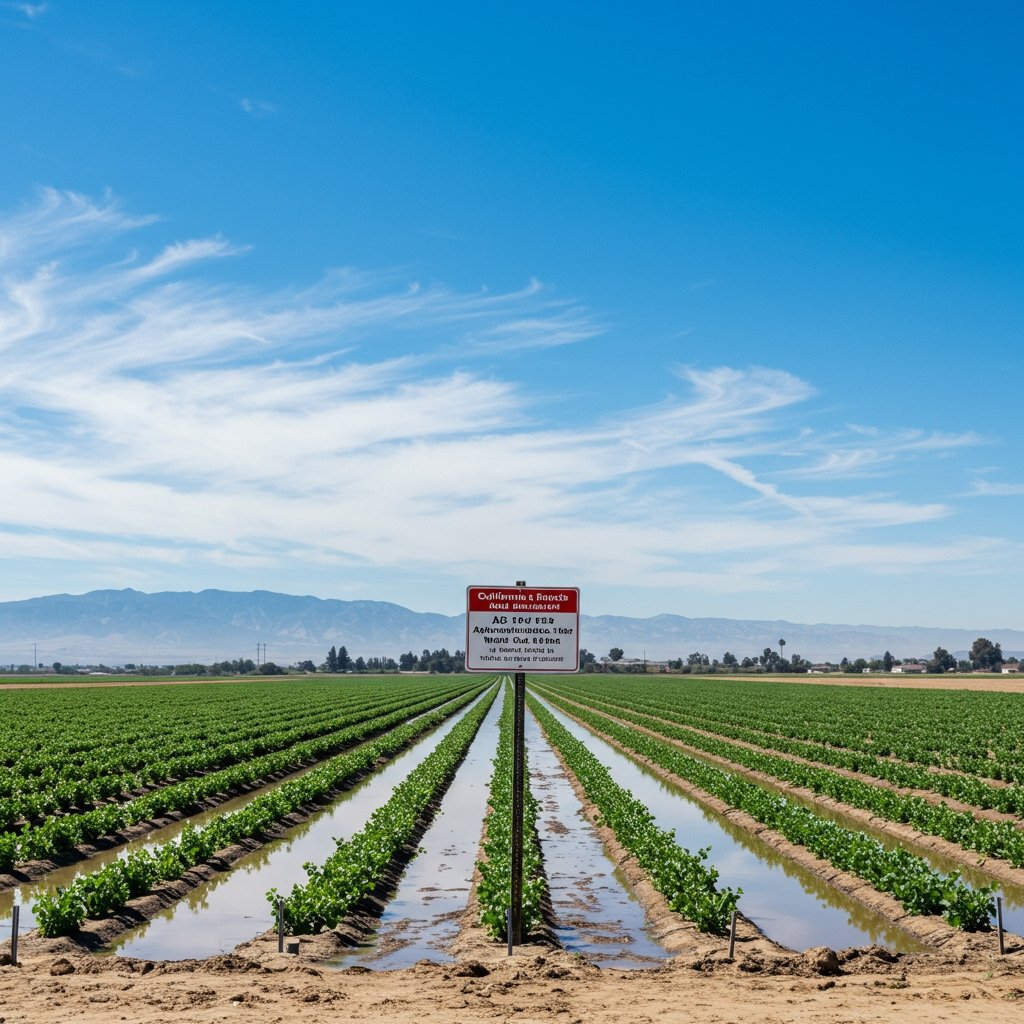California Sets New Agricultural Water Standards
Sacramento, CA – Governor Gavin Newsom signed landmark legislation on June 7, 2025, enacting stringent new water efficiency standards for agricultural operations across California. Assembly Bill (AB) 1234, set to take effect statewide on January 1, 2026, introduces significant mandates aimed at addressing California’s persistent water challenges and promoting sustainability in its vital agricultural sector.
The core of AB 1234 imposes a mandatory 15% reduction in water use measured per acre-foot of yield for specific, high-water-use crops cultivated within designated critical groundwater basins. Crops explicitly targeted by the legislation include economically important commodities such as almonds, alfalfa, and cotton – crops known for their significant water demands, particularly in regions reliant on groundwater resources.
This new regulatory framework represents a substantial step beyond existing water conservation measures, shifting the focus towards efficiency improvements tied directly to crop production. By linking water use to yield, the state aims to incentivize farmers to adopt practices and technologies that maximize output while minimizing water input per unit of production. The designated critical groundwater basins are areas identified by the state under the Sustainable Groundwater Management Act (SGMA) as being critically overdrafted, facing severe declines in groundwater levels and requiring intensive management and reduction in pumping.
Industry Reacts with Apprehension
The agricultural industry, a cornerstone of California’s economy and food supply, has voiced significant concerns regarding the implementation and potential consequences of AB 1234. Advocacy groups, most notably the California Farm Bureau Federation, have been vocal opponents of the bill, citing a range of challenges farmers will face in complying with the new mandates.
Among the primary concerns raised by the Farm Bureau are the potentially significant operational costs associated with achieving the 15% reduction target. Farmers may need to invest heavily in advanced irrigation systems, precision agriculture technologies, and expert consulting to optimize water use and track efficiency metrics. These investments represent substantial financial burdens, particularly for smaller family farms operating on tighter margins.
Furthermore, agricultural leaders express apprehension that achieving the mandated water reduction without impacting crop yields could be exceedingly difficult, if not impossible, in some cases. They argue that the delicate balance required for optimal crop growth relies on specific water inputs, and a forced reduction could lead to reduced harvests or compromised crop quality, directly affecting farm profitability and potentially leading to higher consumer prices for affected commodities.
The Farm Bureau also points to existing drought measures and conservation efforts already undertaken by farmers across the state. Many growers have already implemented water-saving practices in response to previous droughts and regulatory pressures. They argue that imposing a blanket 15% reduction now, on top of existing conservation, may push operations to their limit and not account for the varying conditions and progress already made on individual farms.
Environmental Groups Laud Progress
In contrast to the agricultural sector’s concerns, environmental organizations have strongly supported AB 1234, hailing it as a necessary and crucial step towards sustainable water management in California. The Sierra Club California Chapter, a prominent environmental advocacy group, lauded the bill’s passage, emphasizing its importance in addressing the state’s long-term water security.
According to the Sierra Club, the legislation is vital given the persistent challenges posed by climate change, including reduced snowpack, altered precipitation patterns, and increased evaporation rates. These factors contribute to declining reservoir levels and overall water scarcity across the state, making conservation in the largest water-using sector – agriculture – absolutely essential.
Environmental advocates argue that decades of unsustainable water use, particularly reliance on overdrafted groundwater, have created an urgent need for systemic change. They view the 15% efficiency mandate as a pragmatic approach to reducing agricultural water footprints, promoting the health of critical groundwater basins, and ensuring water availability for all users – including urban populations and environmental needs – in the face of a changing climate.
The bill is seen by environmental groups as aligning California’s agricultural practices more closely with ecological realities and long-term resource availability, shifting away from a consumption model towards one focused on efficiency and sustainability.
Looking Ahead: Potential Impacts and Adaptations
Industry analysts are closely watching the potential impacts of AB 1234 as the implementation deadline approaches. Predictions suggest that the legislation could drive significant shifts within California’s agricultural landscape.
One anticipated outcome is a potential shift in crop planting decisions. Farmers in affected basins growing high-water-use crops like almonds, alfalfa, and cotton may explore transitioning to less water-intensive alternatives, depending on market demand and profitability. This could alter the agricultural profile of certain regions within the state.
The mandate is also expected to accelerate the adoption of advanced irrigation technologies. While drip irrigation and micro-sprinklers are already in use, AB 1234 provides a strong regulatory push for wider implementation and optimization of these systems, which deliver water more directly to plant roots, minimizing waste compared to flood or furrow irrigation.
However, the high capital cost of adopting such technologies remains a significant hurdle, particularly for smaller farming operations. Analysts predict that the transition could disproportionately impact smaller farms that lack the financial resources or access to credit needed for large-scale infrastructure upgrades. This could potentially lead to consolidation within the industry or force some smaller growers out of business.
As California continues to grapple with the realities of climate change and limited water resources, AB 1234 represents a bold, albeit controversial, policy aimed at ensuring the long-term viability of both its agricultural sector and its precious water supplies. The coming years will reveal how effectively the industry can adapt to these new regulations and what the ultimate impact will be on production, consumer costs, and the environment.



















